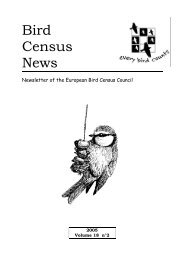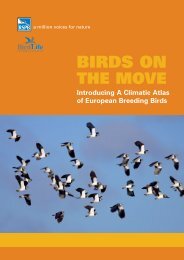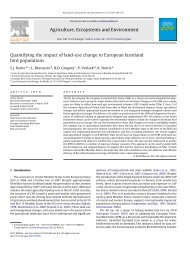monitoring breeding birds in the united kingdom - European Bird ...
monitoring breeding birds in the united kingdom - European Bird ...
monitoring breeding birds in the united kingdom - European Bird ...
Create successful ePaper yourself
Turn your PDF publications into a flip-book with our unique Google optimized e-Paper software.
The f<strong>in</strong>al, and arguably most important, aspect of <strong>the</strong> new scheme was <strong>the</strong> formal sampl<strong>in</strong>g<br />
strategy. Our trials, and similar experience with national surveys of s<strong>in</strong>gle-species (Shrubb & Lack<br />
1991, Donald & Evans 1995), have demonstrated <strong>the</strong> feasibility of a random sampl<strong>in</strong>g design <strong>in</strong> <strong>the</strong><br />
UK. The advantages of this are considerable as it provides <strong>the</strong> only mechanism for produc<strong>in</strong>g what<br />
is demonstably unbiased and thus representative <strong>in</strong>formation (Bibby et al. 1992). A desk-based<br />
study assessed a number of different strategies for <strong>the</strong> selection of survey squares (Gregory &<br />
Baillie 1994, 2004). These simulations showed that simple random sampl<strong>in</strong>g compared very well<br />
with any of <strong>the</strong> more complicated strategies <strong>in</strong>volv<strong>in</strong>g landscape type. It was concluded that a<br />
random selection, stratified by potential observer density, should be used for <strong>the</strong> new survey.<br />
BREEDING BIRD SURVEY<br />
Aga<strong>in</strong>st this background, an annual survey of terrestrial <strong>breed<strong>in</strong>g</strong> <strong>birds</strong> was <strong>in</strong>troduced <strong>in</strong> <strong>the</strong><br />
UK <strong>in</strong> 1994 (http://www.bto.org/survey/bbs.htm). The strategic aims of <strong>the</strong> BBS are:<br />
1) to be based on a formal randomised sampl<strong>in</strong>g design,<br />
2) to improve <strong>the</strong> geographical representation of <strong>monitor<strong>in</strong>g</strong>,<br />
3) to improve <strong>the</strong> habitat representation of <strong>monitor<strong>in</strong>g</strong>, and<br />
4) to <strong>in</strong>crease species coverage of <strong>monitor<strong>in</strong>g</strong> (as a consequence of <strong>the</strong> o<strong>the</strong>r po<strong>in</strong>ts).<br />
The BBS thus aims to provide precise <strong>in</strong>formation on year-to-year and longer term changes <strong>in</strong><br />
population levels for a broad spectrum of common species across a range of regions and habitats.<br />
The parallel record<strong>in</strong>g of land use and habitat change will facilitate a better understand<strong>in</strong>g of <strong>the</strong><br />
factors responsible for population changes, and this will be particularly important for populations <strong>in</strong><br />
decl<strong>in</strong>e. In a wider context, <strong>the</strong> BBS aims to promote a greater understand<strong>in</strong>g of <strong>the</strong> population<br />
biology of British <strong>birds</strong> through a partnership between large numbers of voluteer and a small<br />
number of professional ornithologists.<br />
Selection of survey squares<br />
Survey squares were selected as a random sample, stratified by potential observer density,<br />
from with<strong>in</strong> regions across <strong>the</strong> UK (Gregory & Baillie 1994). The 128 BTO regions were reduced<br />
to 83 regions by <strong>the</strong> amalgamation of <strong>the</strong> smallest ones. Sampl<strong>in</strong>g from fewer, larger regions avoids<br />
<strong>the</strong> problem of extremely small adm<strong>in</strong>istrative regions. The number of squares to be surveyed <strong>in</strong><br />
each region was calculated by multiply<strong>in</strong>g observer desity by a constant and sett<strong>in</strong>g a m<strong>in</strong>imum<br />
level of coverage. We anticipate that professional will be necessary to ensure m<strong>in</strong>imum coverage <strong>in</strong><br />
remote areas.<br />
At a local level squares are allocated to volunteers through a network of voluntary regional<br />
organisers. Each organiser receives a list of target squares for <strong>the</strong>ir region with <strong>the</strong> <strong>in</strong>struction that<br />
squares should be allocated <strong>in</strong> strict order from <strong>the</strong> top downwards. This is essential <strong>in</strong> ma<strong>in</strong>ta<strong>in</strong><strong>in</strong>g<br />
<strong>the</strong> random design of <strong>the</strong> survey. The same squares are surveyed year after year and new volunteers<br />
are found if <strong>the</strong> orig<strong>in</strong>al volunteer drops out. The way <strong>in</strong> which observer changes are handled <strong>in</strong> <strong>the</strong><br />
analysis will be addressed once sufficient data have been ga<strong>the</strong>red. Regional organisers play a vital<br />
role <strong>in</strong> coord<strong>in</strong>at<strong>in</strong>g fieldwork and oversee<strong>in</strong>g <strong>the</strong> return of data. In limited circumstances, <strong>the</strong>y can<br />
report squares as be<strong>in</strong>g uncoverable, for example, because a landowner refuses access permission or<br />
<strong>the</strong> square is complelely <strong>in</strong>accessible. In such cases, <strong>the</strong> square can effectively be ignored, although<br />
organisers submit <strong>in</strong>formation on land use and habitat type to check for any bias <strong>in</strong>troduced by <strong>the</strong>ir<br />
exclusion.<br />
- 104 -






